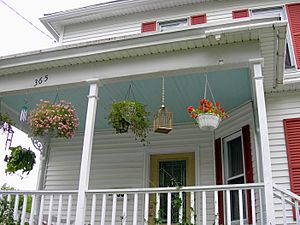Haint blue facts for kids
Haint blue is a group of light blue-green colors. These colors are often used to paint the ceilings of porches in the southern United States.
This special painting tradition started with the Gullah people. They lived in Georgia and South Carolina. For example, a building at the Owens–Thomas House in Savannah, Georgia, built in the early 1800s, had its ceiling painted haint blue. The blue color originally came from crushed indigo plants. Before the American Revolution, indigo was a common crop on large farms in the American South. Even after indigo farming became less common, the tradition of using haint blue continued.
Contents
What "Haint" Means
The word haint is another way to spell haunt. In some old African-American ways of speaking, haint meant a ghost. In a belief system called Hoodoo, a haint could also be a witch-like spirit. People believed these spirits would try to scare victims until they were completely exhausted.
Why People Used Haint Blue
Keeping Spirits Away
Originally, the Gullah people believed haint blue could keep "haints," or ghosts, away from their homes. They thought the blue color might look like the sky, tricking ghosts into flying right through it. Or, they believed it looked like water, which ghosts traditionally could not cross. The Gullah people would paint not just their porches, but also their doors, window frames, and even shutters. They also hung blue glass bottles in trees to catch haints and other spirits like boo hags.
While the Gullah people and their descendants believed haint blue offered protection, the demand for indigo dye had a sad side. It helped increase the terrible practice of forcing people from Africa into slavery during the 1700s.
Modern Uses and Beliefs
Over time, as Gullah culture mixed with the culture of white people in the South, the custom of using haint blue became more common. Today, many people still use haint blue, even if they don't believe in ghosts. Some people think the color helps keep spiders and wasps away. However, scientists have not found proof that the color itself scares off bugs. This idea might have come from old milk paint recipes that contained lye. Lye is a substance that can actually repel insects.
Many people also simply love haint blue because it looks beautiful. It reminds them of the clear blue sky.
See also
- Robin egg blue


